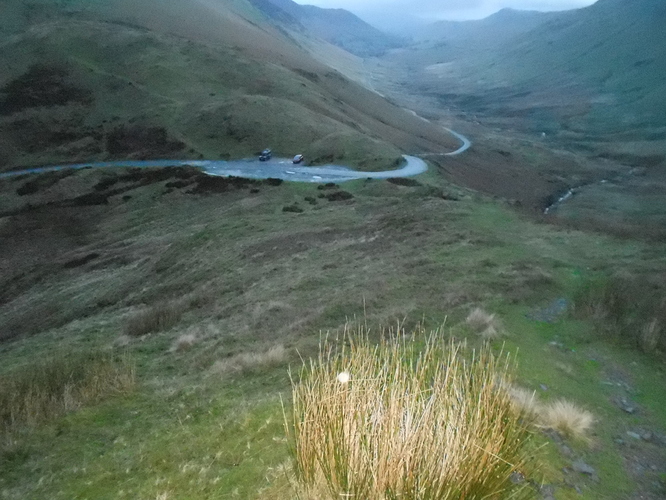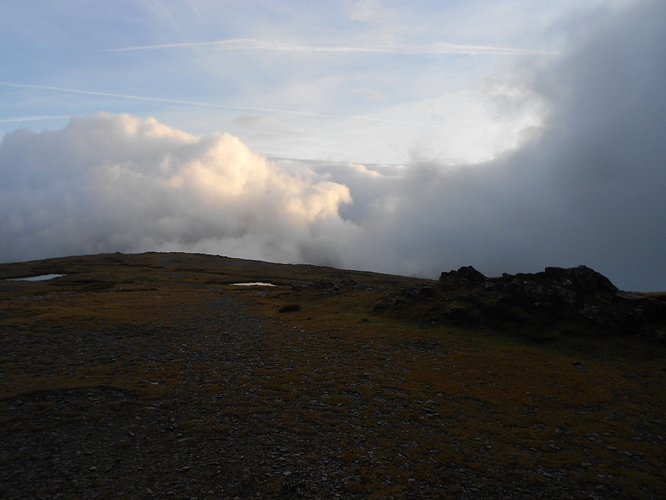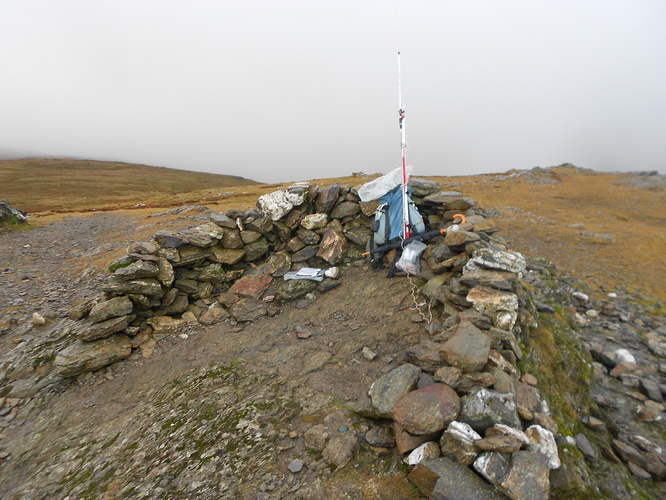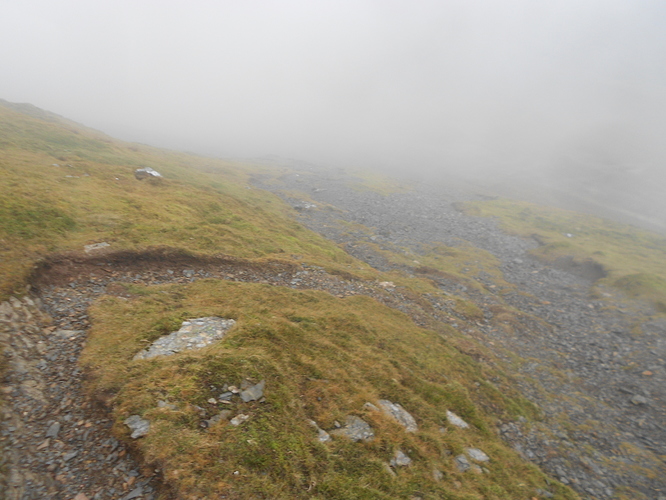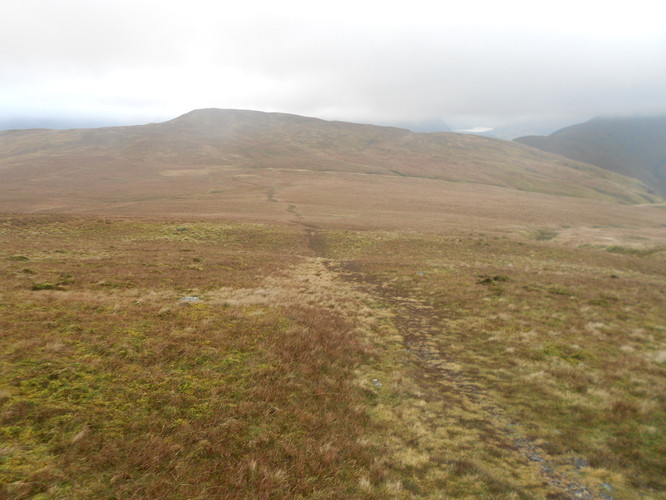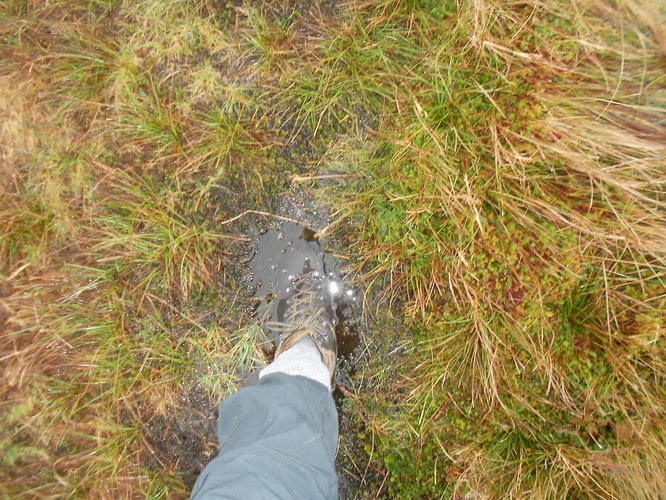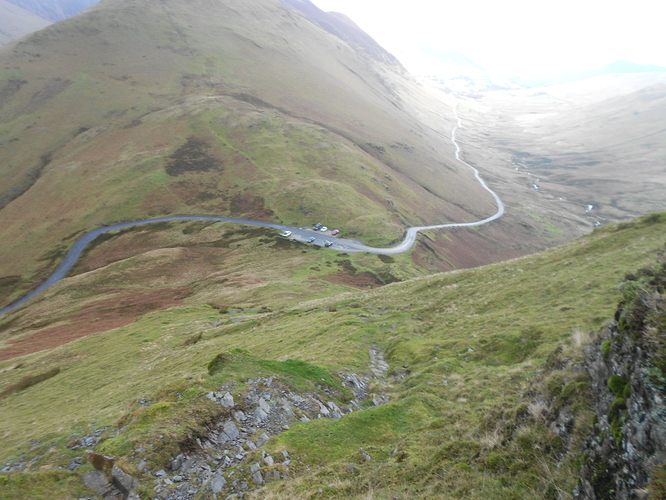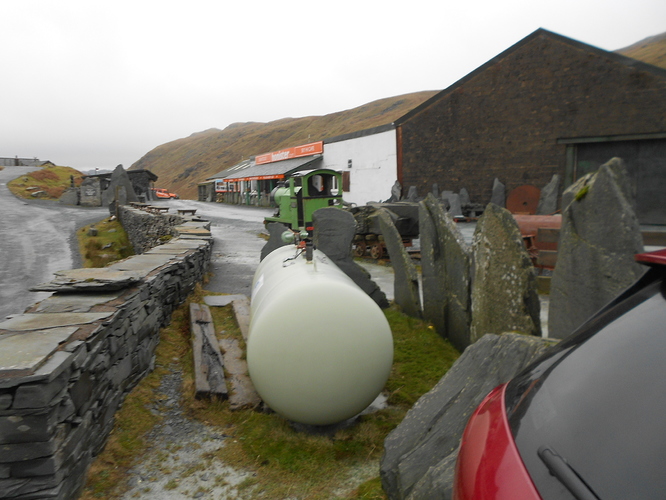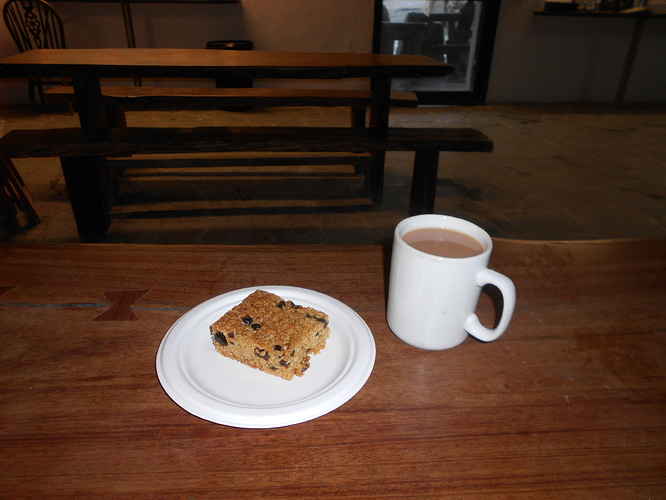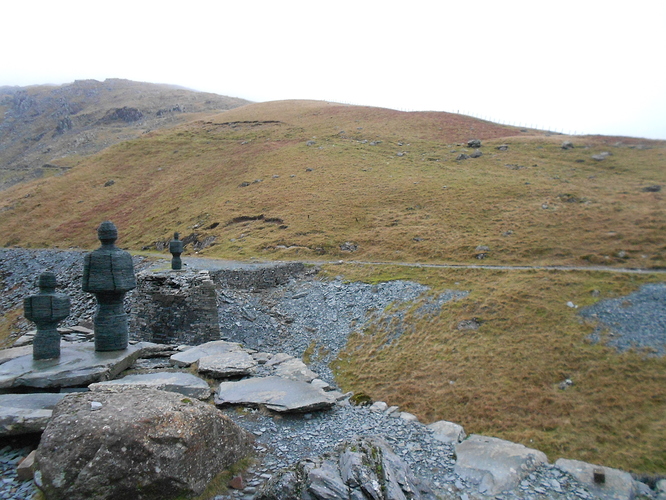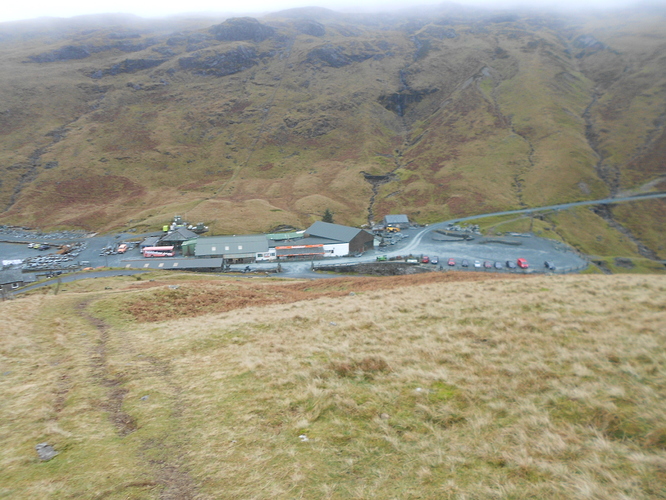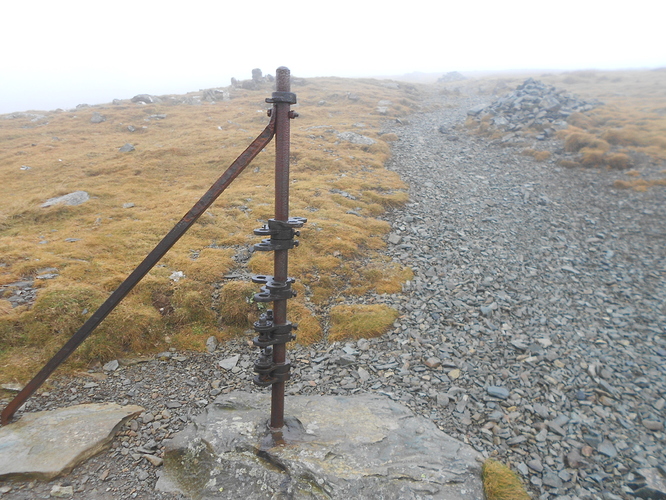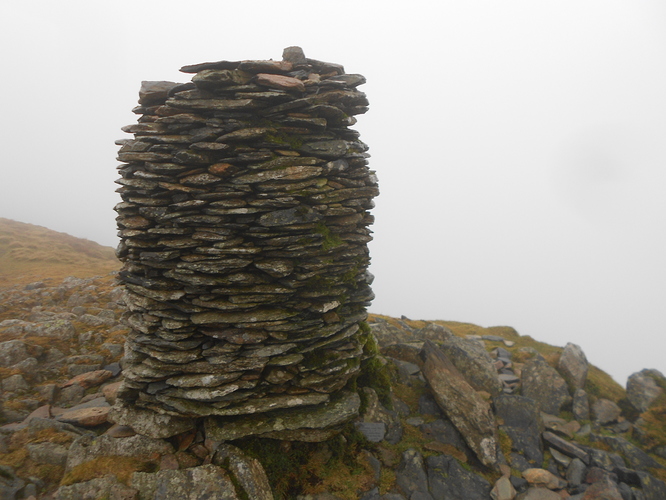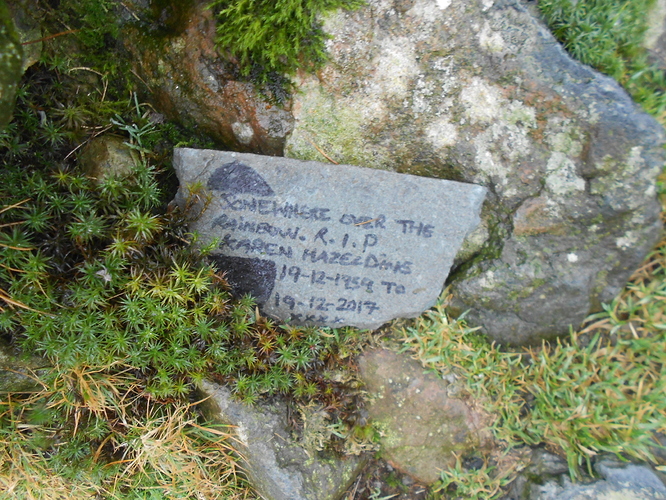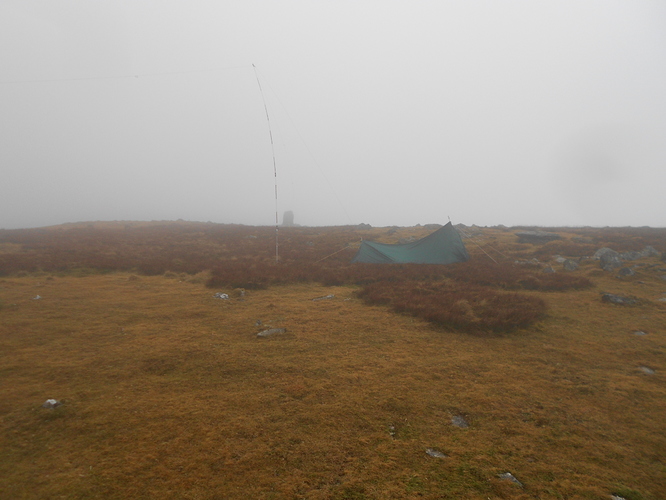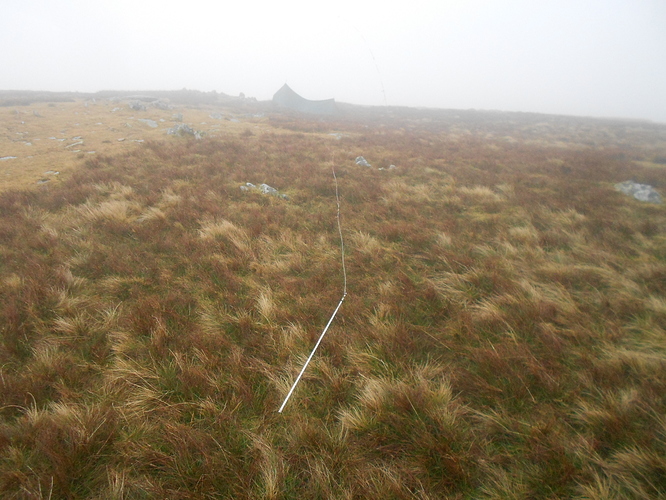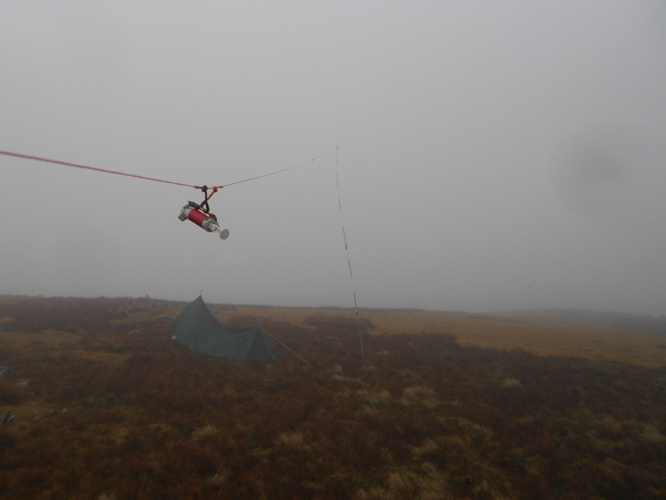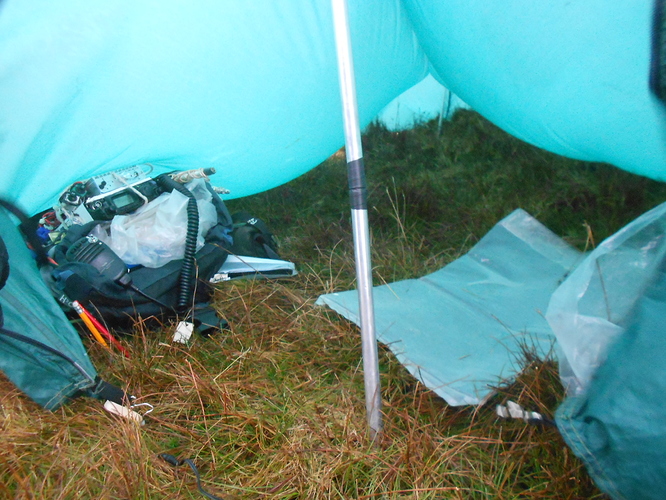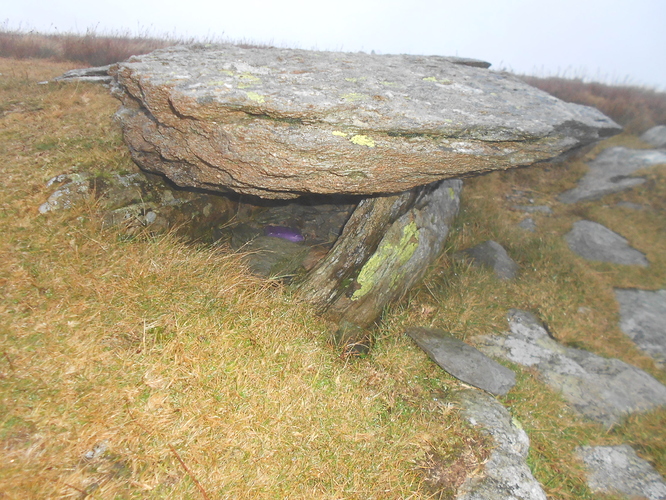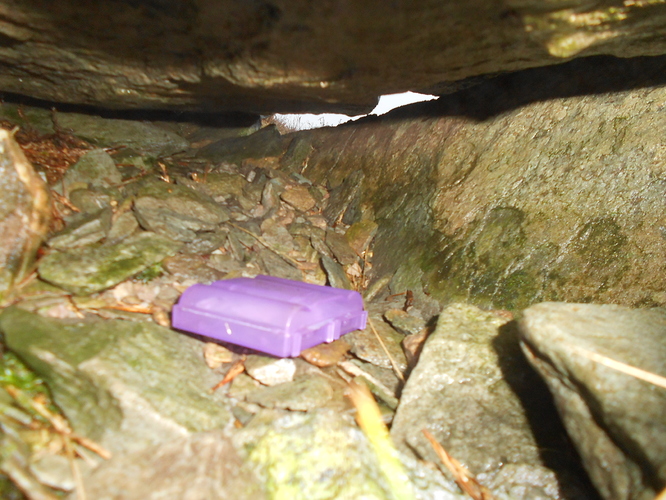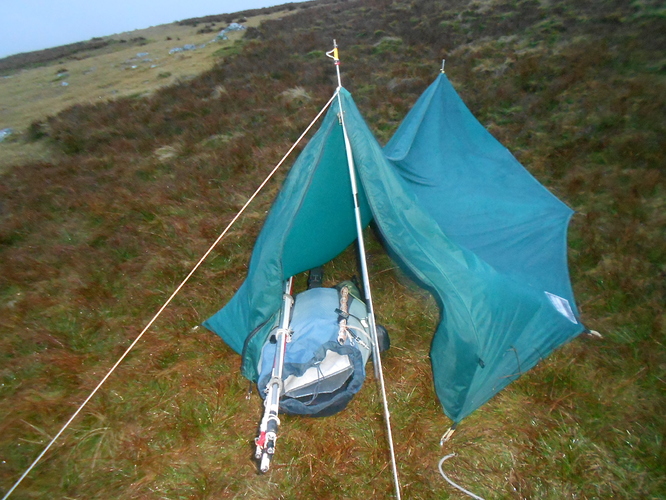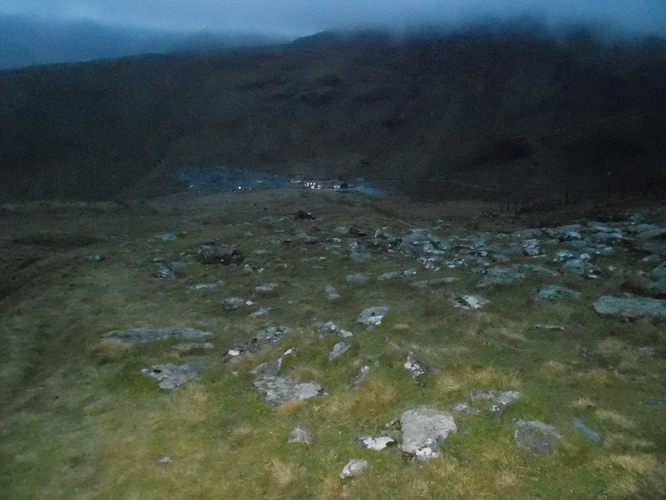G4YSS: Activation of G/LD-021 & G/LD-020, Boxing Day 26-12-18
Issue-1
ROBINSON on 2m-FM QRP & DALE HEAD on 80m & 160m CW/ SSB QRO
Unaccompanied
G4YSS, using GX0OOO/P
All times UTC
EQUIPMENT used:
LD21 – VHF only:
IC-E90 4-Band, 5W, VHF H/H with 1.3 Ah integral battery
2m: Vertical J-Pole
4m: Extended 2m rubber duck (Nil)
LD20 - HF:
FT817ND HF/VHF/UHF 5W Transceiver
MX-P50M HF 50 Watt Linear Amplifier (80 thru 10) with 160m capability
Adjustable link dipole for 80-60-40-(30)-20
HB loading Coils for 160m at the 40m breaks
5m home-brew CFC mast with 1m end sticks
One Turnigy 11.1V, 5 Ah Li-Po battery (tested at 99% depleted)
(All eqpt. carried on both summits)
Pocket Rig: Baofeng UV-3R, 2W, 2m/ 70cm H/H
Pack-weights (est): LD21: 10kg (22lbs); LD20: 11kg (24lbs)
Other:
Garmin Geko 301 GPS
Hitachi MP3 Player
DAB Cube
INTRODUCTION:
The base for this sortie was the Shearings Derwentwater Hotel at Portinscale near Keswick. We booked four nights self-drive (23rd to 27th December) at a cost of £698 for two people. Christmas Eve was taken up activating LD18 Stony cove Pike and LD11 High Street. There is a separate report for these. Christmas day was – simply Christmas Day, thought a bit strange being the first one away from family.
Route:
These two summits are part of the Buttermere Horseshoe but once is more than enough for that! Since then I have been doing them from Honister but the trouble is Hindscarth, a hill which lies midway between the two SOTA’s, must be climbed twice. Furthermore there is no short cut on the way back, so LD20 must also be crossed twice. I make that a total of 840m of ascent. If these two are climbed separately, LD21 from Newlands Hause and Dale Head from Honister Pass, the total comes down to around 800m. Not much of a difference but there’s a saving in distance too. Some activators have done these two as a linear walk, Honister to Buttermere. For that a bus would be handy but maybe not on Boxing Day.
Execution:
Another early breakfast was booked and served, this time by the duty night porter Sergio, at 06:45. Forgetting that the first summit would be done only on 2m-FM, the breakfast booking was too early so I took it slowly, finding out about Sergio’s native Romania at the same time.
The MWIS forecast was for hill fog and strengthening winds but summit temperatures were predicted to be quite high at 6 to 8C. There is currently no lying snow anywhere in the Lake district or Northern Pennines.
It was still dark when I got to the parking place at Newland Hause (NY 1928 1762). Reversing in, a short distance from a LWB Land Rover with someone asleep inside, I awaited daylight and set off walking at 08:19.
Initially it’s a steep pull up to around NY 1906 1732, whence the path levels out and becomes quite boggy in places. Sweeping gradually left via NY 1910 1697 and NY 1926 1685, it starts climbing in earnest for a second time. Here bog gives way to gravel and loose stones and it’s quite easy to follow via NY 1975 1678 and NY 2018 1695, to the top of the hill where there is a poor sort of shelter but better than nothing. I chose to do Robinson first because, given the choice, I would rather walk down Dale Head - LD20 in the dark if it became necessary, as the navigation is simpler.
ROBINSON G/LD-021, 737m, 6pts, 09:15 to 10:24. 6C, SW wind 10 mph, low-cloud (base 520m) lifted briefly. No rain. (LOC: IO84JM, WAB: NY21, No Trig) . Vodafone coverage at summit and much of route.
145.550/ 145.525 FM - 10 QSO’s:
The vertical J-Pole was set up in the shelter where it was a bit windy but not too cold. Now the moment of truth. With visions of struggling to qualify, I had brought along the HF gear, hoping not to have to use it. The weight penalty for this was over 3kg which might help to explain the nigh on 1 hour ascent time. That and the bogs.
Switching on the IC-E90, I could hear signals straight away. There was an Irish net on .475 and an even stronger signal on .550. I listened for a minute or two and heard the words ‘Low-Cloud.’ Could this be a summit? Assuming it was, I called ‘Summit to Summit’ and was not disappointed. Jordan M3TMX/P answered from Pen-y-Ghent G/NP-010. We had a really good chat for a while and it seemed that neither of us were yet qualified. With that I QSY’d down a channel and left Jordan to get on with the job of logging four stations, which he later told me he had.
After the S2S, I went on to work: G1OHH and G7CDA - Sue and Douggie in Lancaster; G0TDM John - Penrith; MI6LNP Norman in Antrim ; GW4VPX Allan at Pencader; M1AVV Simon on Walney Island; MW1FGQ John - Flintshire; G4ZRP Brian on the Wirral Peninsula and Geoff GM4WHA in Annan.
Sue was looking forward to introducing her granddaughter to a weaving loom but also flagged up that G4ZRP was calling me. Good job too as I heard nothing from Brian until the squelch was defeated!
Allan seemed quite animated. I think he hadn’t expected to work me but it came to pass at 51/ 41.
Simon’s was a ‘long time no hear’ callsign who I will long remember, having worked him on 2m-FM from NP18 right across midnight when the year changed from 2003 to 2004.
John MW1FGQ was due to go out bird watching so the QSO was necessarily short.
Geoff told me the bad news that he may well be expected to move his work QTH from Penrith to Carlisle. The latter computer shop is in a bad place radio wise so the SOTA/ WOTA listening service that Geoff provides in conjunction with John G0TDM will be no more. With so few on 2m these days, that will be a significant blow indeed. It’s not so good for Geoff either!
Norman was the chef on Christmas day but today the food was on someone else. All stations sent their seasons greetings and these were returned of course.
Why had I worried? Far from struggling, I had ten QSO’s to boast about. On the down side the rucksack full of redundant HF gear felt even heavier on the return.
70.450 FM – Nil:
A couple of quick calls on 4m were tried but without result. For this I used the usual arrangement of the IC-E90 and 2m rubber duck extended with a short section of stainless steel welding rod. It’s quick and easy and usually works well but nobody heard today’s signal. However, I’d advertised it on the alert so it had to be tried.
Descent of LD21:
Leaving approximately in accordance with the time schedule, I found and GPS marked a path which cut the corner somewhat. Slightly lower in altitude, this made the return slightly more boggy than the ascent but there was nothing greater than boot depth. It did save time however, along with a bit of unnecessary ascent. Once in the past I cut this smooth right-hand curve too severely with the result – wet socks. The number of cars parked in the two pull-offs on arrival at 11:02 had grown to six; walkers were on the move again after a day of festivities.
Drive to Honister Pass:
It didn’t take long to drive alongside Buttermere and up to the 356m ASL start point for LD20. Arriving there too early at around 11:15 and parking in the Honister Mine car park, I spotted what looked like a cafe inside the building. Knowing it would be pretty wild at the top of Dale Head and desiring to put 160m on as late as possible (within reason), I was loathe to set off walking too early. The cafe didn’t have scones but there was soon a pot of tea and a large lump of fruit flapjack on the table in front of me. I don’t usually take my eye off the ball or insert ‘civilisation’ between my SOTA’ing, so this made a pleasant change as well as wasting some of the excess time. After going back to the car for the rucksack, the ascent started at 11:45.
DALE HEAD G/LD-020, 753m, 6pts, 12:26 to 15:57. 6C, SW wind 30 mph, low-cloud (base 560m) lifted briefly later. No rain. (LOC: IO84JM, WAB: NY21, No Trig) . Nil Vodafone coverage on summit or route.
After looking at a tiny memorial stone at the foot of the stone stack which marks the summit, finding an operating place was the next priority. Everywhere was windy with scudding low-cloud except for the steep but sheltered north face which wouldn’t support a tent. An exposed position would have to be accepted, meaning more or less anywhere would do. Basing the decision on the path positions versus antenna length but at the same time drawn to the distinctive rock under which there’s a small hollow space, I pitched the flysheet on the longer and darker of the two types of grass. I didn’t want to drop more than a metre in ASL in case VHF should be needed as a backup.
I wouldn’t have enjoyed fighting with a flysheet which has to have its poles threaded through but mine is a simple ridge design. Of the two I have, this is the lighter one-man version and since poles and pegs have all been made captive, it is relatively easy to erect in brisk winds. Even so, in the short time it took to peg out the rear end and guy line, the rest of it had two twists in it. In most places the soil is only 3 or 4 inches deep which presented further problems when the time came to erect the mast.
With all issues overcome, I crawled into the relative calm of my temporary shelter but the fabric was flapping noisily and this was to cause trouble later.
3.557 CW - 9 QSO’s:
Pretty well where and when I said I’d be but with no phone coverage, I was hoping G4SSH would be listening. Roy came back first call with ‘sunny in Scarborough’ and reporting my signal at 559. Roy was 589 to me which indicated decent conditions over that short distance at least, so I sent my weather report. Now at least I could get a spot but the moment Roy clicked to launch the spot, his computer crashed. All the chasers had to go on was my alert of the evening prior, unless they were actually listening that is. In fact as well as Roy, at least one op seemed to be looking for me. ‘G4WSB’ came into the headphones. Bill was coming in at 569 but gave my 50 Watts 379. Conditions not so good after all then?
I think there was some communication between Roy and Bill. I had other things on my mind but it transpired that Bill spotted me and from then on, ‘we were away’ as they say.
Further stations worked with 30 Watts: G4OBK Phil 599/ 579; G3VQO Les 579/ 339; EI6FR Declan 599/ 569; G3RMD Frank 599/ 559; GW4VPX Allan 599/ 559; G4OOE Nick 599/ 579 and SM0OEK Jaan 599/ 539 (SM SOTA Activator – CW only).
It took half an hour for the nine stations worked. Conditions didn’t allow me to be heard by all straight away. It seemed that one or two ops were waiting for the QSB peaks to make my signal audible.
The wind was quite fierce outside and because this was just a flysheet, quite significant inside too. Even with phones on, the racket being produced by the open and flapping tent door was completely overpowering my sidetone for whole characters or more so I was relying an rhythm and timing to fill in what I could not hear. Mittens were needed by the end which made sending even more difficult and what little I could hear of it, the Morse was pretty dreadful much of the time.
3.760 - 16 QSO’s:
The QSY to 3.760, which sounded unoccupied, was picked up on 3.557 and spotted by Bill G4WSB, still standing in while Roy struggled to cajole his desktop back into life. Actually, when I checked if the frequency was in use, Brian G8ADD came right back to confirm it was clear and to ‘go ahead.’ How convenient. I like it when this happens because it makes my life easier as well as saving time which is sometimes in short supply. As well as Brian, others do this too, namely G0RQL, G0FEX, G4IAR and one or two more, not forgetting G4SSH and G4OBK on 160m of course.
There was no controller as such today but I soon realised that plenty of WAB ops were listening on the side. In the log: G8ADD Brian 2 x 59; GI0AZA Esther 59/ 57; G0FEX Ken 59/ 57; MM3PDM Peter 57/ 55; G4OBK Phil 59+/ 57; MM0XPZ Steve 59/ 55 and G3OKA John (‘Old King Arthur’) 2 x 59.
Continuing: GI4ONL Victor 59/ 56; GM4WHA Geoff 55/ 47; MW6IUT Brian 55/ 44; M3FEH Karl (who will be 2E0FEH on 1st of January) 2 x 55; G4RMD Frank 59/ 55 with ‘slow QSB’; PA7ZEE Geert 55/ 31 and struggling; MI1AIB/ M Paul (mobile in H68 & H58 squares) 52/ 51 & 51/ 51; G0BFJ Brian 58/ 44 and finally G6NHW/ A, Pete 57/46.
Phil G4OBK asked me to listen out for Geoff M0PYG but nil heard after I called him. While I was working Frank G3RMD, the ‘heartbeat’ suddenly appeared and was quite noticeable, continuing until after I left the channel. After working MI1AIB/ M the first time, I asked if he needed the frequency for a mobile run. Paul encouraged me to continue but soon after that, all who wanted to had worked me so I left Paul in charge. With a power of 30 Watts, this session spanned 25 minutes. Thanks again for the use of 3.760 (NY21 - No Trig).
Antenna on the ground:
When I went out to fit the Top Band loading coils, I found that half the aerial system was lying on the grass. Just when this had happened was unclear but the westernmost carbon-fibre end stick (the one nearest the summit monolith) had completely broken off at ground level. This remains a mystery but at one stage I did see some walkers pass with a dog.
In the mid 1990’s, my son Phil G0UUU and I were operating /P on 6m-FM QRP from Seamer Beacon, our local high point near Scarborough. A dog that we’d taken with us for a walk, suddenly attacked one of the sticks holding the guys and pulled the entire mast down, putting us off the air in mid QSO with the OH station. Dogs often think sticks are fair game and maybe that happened on Dale Head too. The only other reasonable explanation is that someone walked on it. A wind speed of 30 mph would have had no bad effect. I have been using this same pair of items for 15 years or more and have operated in higher winds than that without a problem.
1.832 CW – 2 QSO’s:
A bad omen for conditions, it was 15 minutes after QSY to 1.832 (which was at 14:35z) that Roy G4SSH heard and then spotted me. At least he’d got his computer back on line. Unfortunately, as I later found out, my long succession of CQ’s briefly appeared then disappeared below Roy’s noise floor, never to return again.
I heard a long CQ from UR9MU at about 529 but there was no chance of him hearing my mouse power.
In fact conditions on 160m turned out to be way down on Christmas Eve two days before. Even Phil G4OBK could barely hear me but we did exchange at 14:53 (579/ 349). In an email the next day, Phil pointed out that the path between us would have been significantly attenuated by the Helvellyn range. That would be especially true in daylight which it still was.
In fact when I worked Phil, there was still an hour to go before sunset. I should have stayed later for better conditions but the repeated CQ’ing, the racket produced by the wind and a repeatedly flailing (and hazardous) metal tent peg were factors that started to wear down my resolve.
At 14:59, with the AF gain fully up to combat the wind noise, a loud signal hit my ears. This was Victor GI4ONL in Bushmills. He was 579 to me but I only got 339 back. Still it was a good QSO and I was very grateful. Victor’s turned out to be the last QSO of the day.
Tantalising responses to my CQ’s followed by a lack of decent band conditions for successful development into QSO’s, further reduced morale. I heard Frank G3RMD call in several times between 14:40 and 15:10, asking for a response to his 229 report for me. No matter how hard I tried it couldn’t be done. Frank was coming in at 559 with a bit of QSB but always audible. Geert PA7ZEE fell into this category too but he didn’t hang around quite so long.
1.846 SSB - Nil:
After more than an hour mainly on CW, and mostly CQ’ing, I tried SSB for about the fourth time but like before, there was nothing doing. The old favourite of many years, 1.843 was blocked by deafeningly loud data signals again. It will be abandoned. Flicking onto it is painful, so the 160m SSB memory channel has been reprogrammed to 1.846. Unexpectedly band conditions did not improve over the period. I assumed that 160m would start to propagate with half an hour to go before sunset but it was just as bad as when I’d first started. My final CQ’s on CW and SSB were at 15:40, ten minutes prior to sunset. Still there was nothing doing.
Final descent:
It wasn’t a day for leisurely packing up and despite there being extra equipment deployed, the process took only 15 minutes. The tent was untidily rolled up and attached to the rucksack but care is needed to ensure that the attached pegs do not puncture the fabric. After one false start, thinking I’d lost my mittens, the walk down in diminishing light took 31 minutes to 16:24. It was a relief.
After debooting, the drive back to Keswick via Buttermere, took until 17:10. As if to rub in the lack of Top Band success, along the way the car radio was delivering a strong signal from Radio Caroline’s 1 kW Orfordness transmitter on 648 kHz. In fact it was armchair copy with minimal QSB. The same applied to Manx Radio on 1368 kHz, and that’s a lot nearer to 1832, so ironically the ‘D’ layer had probably ‘sneaked off’ not long after I packed up.
Comments:
All targets were met but Top Band on the last one was tedious to say the least, both for me and not forgetting the chasers who showed their determination despite a general lack of success. The ‘D’ layer didn’t retire to bed properly, well not on my watch at least and the fact that Medium Wave was ‘jumping’ on the drive back to the hotel only made it worse. You need a bit of luck for Top Band but there was none today. I regret not scheduling it better.
As before, 80m did a great job in making the log look respectable and that was especially true of SSB and the Worked-all-Britain frequency. CW did acceptably well too. I don’t know how many 80m SSB QSO’s were completed with much of the antenna at ground level but past experience has shown that this makes less difference than you’d think. It certainly gives scope for gaining a few contacts even if you forget the mast altogether or can’t erect it due to terrain or high winds. This happened to me on Grisedale Pike one winter with very high winds and blowing snow. You couldn’t stand up for long let alone deploy a dipole. With just two from the four mast sections roughly stuck in a drift and 2/3 of the wire on the snow, I was still able to log a few QSO’s on 80 and 160. I’ll never know how the end stick got broken today as it’s only supporting a 24 AWG wire dipole. This is (was) a strong and ‘bendy’ 1m long home-brew carbon-fibre rod with a diameter of 6.5mm and a weight of 70 grams.
Had 80m not worked, the alternative would have been 2m-FM. In fact there would have been time to add 2m between 80m and 160m but the lack of mobile phone signal did not allow 160m to be put off until a later time. In line with the alerts, chasers would reasonably expect me to be on 160m a few minutes after leaving the WAB net. If I’d delayed for say 45 minutes, possibly nobody would have been listening on 160. There are limits to how much you can inconvenience chasers, especially on Boxing Day. Apologies to Sue G1OHH for not making an appearance on VHF in the afternoon.
Whilst on the subject of 2m-FM, getting ten stations in the log in the morning from Robinson (LD21) came as a surprise. I lost some sleep worrying about qualifying but in the end, the 3kg plus of HF kit wasn’t required. Climbing Robinson took longer than expected due to a ‘round the houses’ ascent route and boggy ground.
Though the weather wasn’t a problem in the morning, increasing wind speeds and low-cloud on Dale Head did not help the cause any. The worst effects of the wind were the flailing tent peg, which wouldn’t stay put due to the shallow soil and the overpowering of my CW sidetone. The latter has been turned up from ‘25’ to ‘50’ after returning home.
What a pleasant interlude – the café at Honister Mine. I usually don’t have (or make) time for this kind of luxury.
QSO’s (10):
LD21:
2m-FM: 10
4m-FM: 0
LD21 (27):
80m-CW: 9
80m-SSB: 16
160m-CW: 2
160m-SSB: 0
Walk data:
08:19: Left Newlands Hause
09:15 to 10:24: LD21 summit
11:02: Arr. Newlands Hause
11:45: Left Honister Pass
12:26 to 15:57: LD20 summit
16:24: Arr. Honister Pass
Driving: 23 miles (Hotel, LD21, LD20 & back)
Times:
LD21: 56 min up, 38 min down
LD20: 41 min up, 27 min down
Total: 2hr-42min
Summit time LD21: 1hr-9min
Summit time LD20: 3hr-21min
Total: 4hr-30min
LD21: 406m ascent/ 4.6km walked
LD20: 397m ascent/ 4.4km walked
Total ascent/ distance: 803m (2,634ft) with 9km (5.6 miles) walked
Distance – Total Driven: 343 miles (cross country (A66) twice plus the two SOTA days)
Thanks to all stations worked, especially the long suffering Top Band chasers and to spotters: G4SSH; G4OBK; G0TDM; G4WSB & G3RMD. Thanks to Roy G4SSH and Phil G0OBK for responding to emails. Thanks to Honister Mine café, Derwentwater Hotel and finally to my XYL for the use of her car.
73, John
(G4YSS using Scarborough Special Events Group Club Call GX0OOO/P)
……………………
Photos:
LD21: 1-2-6-16-17-20-22
LD21: 23-27-25-30-33-35-36-43-48-53-56-67-65-69-71
Above: Leaving Newlands Hawse in early light
Above: Summit of Robinson G/LD-021
Above: Activation of Robinson G/LD-021 on 2m-FM
Above: Descent of G/LD-021. Initial steep section
Above: Descent of G/LD-021. Flat boggy section
Above: Descent of G/LD-021.
Above: Descent of G/LD-021. Final steep section down to Newlands Hawse
………………………………………………………………………………………
Above: Honister Slate Mine
Above: Honister Slate Mine Café
Above: Dale Head from Honister Slate Mine
Above: Path to Dale Head from Honister Slate Mine
Above: Path to Dale Head G/LD-020
Above: Summit of Dale Head G/LD-020
Above: Summit of Dale Head G/LD-020. Miniature memorial stone
Above: Activation of Dale Head G/LD-020
Above: Activation of Dale Head G/LD-020. The broken end stick - aerial wire on the ground (80m SSB).
Above: Activation of Dale Head G/LD-020 on 160m. Coil height a function of wind speed
Above: Activation of Dale Head G/LD-020. The hazardous tent peg
Above: Geocache? on Dale Head G/LD-020. It wasn’t there last time.
Above: Geocache? on Dale Head G/LD-020
Above: Dale Head G/LD-020. Almost ready to leave
Above: Back to Honister
Footnote:
Thanks for replies to last report. Haven’t even read them yet!
All being well, hope to be on G/N-032 over midnight for New Year/ 160m.
73, John
